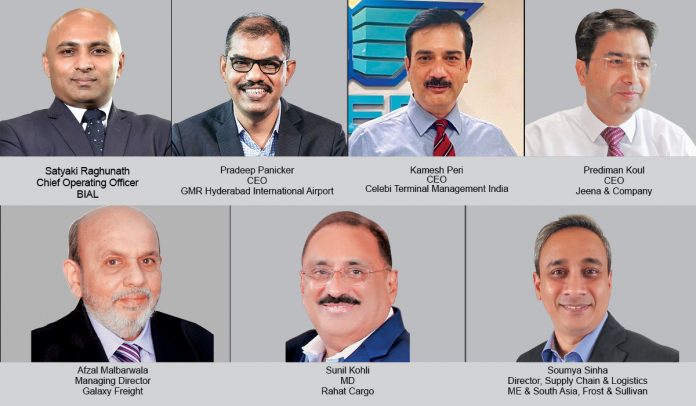India, charting a transformative course in air cargo and logistics, establishes itself as a transshipment hub. This evolution is poised to enhance economic growth and reinforce its position in the global supply chain. The country’s geographical location provides it a natural advantage for cargo operations.
Ritika Arora Bhola
India’s air cargo sector is on the brink of a major transformation, as it positions itself to become a transshipment hub. This evolution marks a shift in global logistics, promising enhanced connectivity, economic growth, and advantages for the country’s aviation industry. India’s central location between key global markets, combined with its expanding aviation infrastructure, provides it an advantage in the cargo sector. Airports such as Delhi, Mumbai, Bengaluru, and Hyderabad are undergoing infrastructure upgrades. These enhancements are designed to streamline operations and accommodate increasing cargo volumes, making Indian airports ideal for transshipment activities.
The growth of India as a transshipment hub is likely to have a substantial economic impact on the economy. Increased cargo traffic through Indian airports will generate substantial revenue and create job opportunities in logistics, warehousing, and transportation sectors. This growth will foster development of related industries, such as cold storage and e-commerce fulfilment to boost the economy.
The integration of advanced technologies is a significant factor in India’s prospering role as a transshipment hub. Airports are adopting advanced cargo handling systems to improve efficiency and reliability. These technologies are critical in managing the complex logistics of transshipment, ensuring that goods are handled swiftly and accurately as they move through the Indian airspace.
India’s emerging role in air cargo transshipment reflects broader trends in international trade. As trade routes become increasingly complex, the need for efficient transshipment hubs has grown. India’s geographical location and infrastructure make it a viable option for airlines and logistics firms looking to connect with major markets in Asia, Europe, and the Americas.
The Indian government is supporting the development of the country’s air cargo sector through various initiatives and policies. Programmes such as the National Civil Aviation Policy (NCAP) and development of dedicated air cargo corridors are designed to enhance infrastructure, reduce regulatory hurdles, and promote investment. These efforts are critical in positioning India as a competitive player in the global air cargo market. While the prospects of the industry are promising, several challenges need to be addressed. These include overcoming infrastructure limitations, ensuring efficient customs procedures, and maintaining high standards of security and safety. The government and the industry stakeholders collaborate in order to address these challenges or issues through planning and investment in infrastructure development.
As the sector continues to evolve, it will contribute to India’s economic growth and global trade integration. CARGOTALK discusses with industry experts whether it is ready to become a global transhipment hub amid ongoing several trade disruptions such as Bangladesh crisis, Russia-Ukraine war, global economic slowdown and recession.
Rail, road links & last-mile connectivity main hurdles
Satyaki Raghunath, Chief Operating Officer
BIAL While India has the potential to become a global transhipment hub, there are hurdles that need to be addressed. The existing cargo infrastructure in India demands improvements to align with the standards set by established transshipment hubs worldwide. The last-mile connectivity and road and rail links to major ports and airports hinder seamless cargo movement, affecting the efficiency of transhipment operations. Equally crucial is the need for a skilled workforce equipped with the expertise to manage and oversee the operations of a transhipment hub. The country also faces stiff competition from well-established transhipment hubs, such as Singapore, Dubai, and Colombo.”
Transshipment cargo to improve last-mile delivery
Pradeep Panicker, CEO, GMR Hyderabad International Airport
India’s location between Southeast Asia and Western markets makes it a prime transshipment hub for global trade. By consolidating cargo from both regions, airlines can optimise routes, reduce costs, and enhance service. Sectors such as textiles, electronics, pharma, and perishables offer opportunities for growth. In addition, the freight rates may decrease due to the combined volume of EXIM and transhipment cargo in freighters. Increased transhipment activities will enhance linkage, which will also improve delivery times for Indian EXIM cargo. GMR Hyderabad International Airport is geographically well positioned in India to be a transshipment hub.”
Increasing volumes make India an attractive hub
Kamesh Peri, CEO, Celebi Terminal Management India
India’s potential as a global transhipment hub is bolstered by its strategic location, growing economy, and infrastructure improvements. Celebi, with its expertise in cargo handling, is committed for this transformation. India’s geographic advantage along with major maritime routes and its expanding trade volumes make it an attractive hub. The freight corridors and airport expansions further support this shift. Infrastructure gaps at airports cause congestion and inefficiencies, limiting cargo throughput, complex regulations create bottlenecks in cargo movement and customs clearance. Lack of coordination among various transport modes affects overall logistics efficiency.”
Govt initiatives support logistics infrastructure
Prediman Koul, CEO, Jeena & Company
India is well positioned to become a global transshipment hub. With robust economic growth driving trade volumes, the nation is making progress in port modernisation and logistics infrastructure, supported by government initiatives. The country benefits from its location along key maritime routes in the Indian Ocean linking Asia, the Middle East, and Africa. While current disruptions present challenges, technology advancements and investments in the transportation networks enhance operational efficiency.”
India to improve its role in global transshipment
Afzal Malbarwala, Managing Director, Galaxy Freight
India’s ambition to become a global transhipment hub involves upgrading and expansion of Mumbai, Chennai, and Kolkata ports to handle larger vessels and increased volumes. Enhancing inland transportation networks, including rail and road links, to facilitate smooth movement of goods from ports to inland destinations. Implementing advanced port management systems and automation increases efficiency and reduces TAT. Streamlining customs procedures and reducing bureaucratic hurdles to make it easier for global shipping lines to operate in India. By focusing on these areas, India aims to enhance its role in global maritime trade and improve its competitiveness as a transhipment hub.”
Must plug gaps to become global transshipment hub
Sunil Kohli, MD, Rahat Cargo
India has been growing towards an enhanced economy apart from improving an all-round infrastructural support, yet there are several factors to be considered, while trying to make the country as a global transhipment hub. NLP has taken aspects of logistics into account knitting together all the dimensions—warehousing, different modes of transportation, packaging and metal handling. Temperature plays a vital role in retaining the longevity of agri products, hence shifting from a cold place to a warm one may cause deterioration of contents without cooling facilities. Steps need to be taken to plug all the existing gaps before India is considered fit to be a global transhipment hub.”
External dependence leading to revenue loss
Soumya Sinha, Director, Supply Chain & Logistics, ME & South Asia, Frost & Sullivan
In 2022, Indian transshipment cargo volume was 4.6 million TEUs, out of which 4.2 million TEUs were handled at foreign ports. This shows 75 per cent of Indian transshipment cargo is handled outside the country. This reliance on external infrastructure translates to missed opportunities for revenue generation and economic growth. The Indian transshipment cargo destinations are Colombo, Singapore, and Klang. Dependence on foreign ports results in a loss of US$200 to US$220 million annually for Indian ports, representing untapped potential revenue from Indian-origin and Indian-destination containers. Key rail routes carrying bulk cargo, face capacity and other limitations.”















